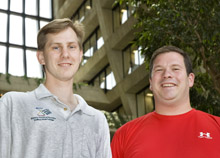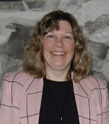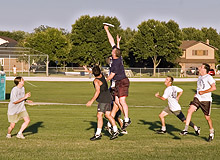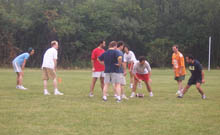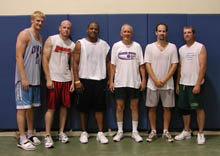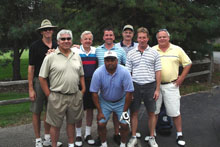 |
Wednesday, August 16, 2006 |
|
Wednesday, August 16
Thursday, August 17
Click here for a full calendar with links to additional information. |
|
Extended Forecast |
Secon Level 3 |
|
Wednesday, August 16 -Vegetable Beef -Fish & Chips -Almond Crusted Sole -Country Fried Steak w/Pepper Gravy -Beef & Cheddar Panini w/Sauteed Onions -Assorted Slice Pizza -Cavatappi Pasta w/Italian Sausage & Tomato Ragu |
|
Wednesday, August 16
Thursday, August 17
Chez Leon Menu |
| Fermilab Today is online at: http://www.fnal.gov/today/ Send comments and suggestions to today@fnal.gov Fermilab Today archive Hurricane Relief Page Fermilab Today PDF Version Fermilab Result of the Week archive Fermilab Safety Tip of the Week archive Linear Collider News archive Fermilab Today classifieds Subscribe/Unsubscribe to |
| Fermilab boosts physics education with QuarkNet | |||
| |||
|
When physics teachers David McClary and Larry Hiller first heard about the QuarkNet program through the particle physics group at the University of Buffalo, the teachers thought the program seemed too good to be true. Would QuarkNet simply donate a cosmic-ray detector to their school? "We ultimately found out that we would do research at Fermilab for four weeks and then take a detector home with us," McClary said--an opportunity even better than they had imagined. "The day after we found that out, we were both on board."
This summer, both teachers worked at Fermilab's Silicon Detector facility and helped with the Forward Pixel Detector, a tracking device for the CMS detector at CERN. "We didn't expect to work quite as independently as we did," McClary said. The physics duo also received tours of Fermilab that provided additional information to take back to the classroom. "This has been something beyond anything either of us imagined," McClary said. "It's just been outstanding." Returning home, the teachers from North Tonawanda High School in New York will assemble the cosmic-ray detector. CMS physicist Avto Kharchilava, one of several particle physics experimenters and theorists hired by the University of Buffalo to start a new particle physics group, will be the local QuarkNet mentor. When operational, the cosmic-ray detector will provide data online so other schools can use its data, too. "The detector will be linked with other schools in Rochester and Syracuse," Hiller said. "The fact that so many students will be able to play with this thing is really exciting for us." Instead of just memorizing the names and properties of particles, the cosmic ray detector will give students a chance to participate in a high-energy physics lab experience, Hiller said.
More information about QuarkNet, which is funded by the National Science Foundation and the DOE Office of Science, is available online.
|
|
Time,
August 11, 2006:
The Unraveling of String Theory By now, just about everyone has heard of string theory. Even those who don't really understand it--which is to say, just about everyone--know that it's the hottest thing in theoretical physics. Any university that doesn't have at least one string theorist on the payroll is considered a scientific backwater. The public, meanwhile, has been regaled for years with magazine articles breathlessly touting it as "the theory of everything." Brian Greene's 1999 book on the topic, The Elegant Universe, has sold more than a million copies, and his Nova series of the same name has captivated millions of TV viewers. But despite its extraordinary popularity among some of the smartest people on the planet, string theory hasn't been embraced by everyone--and now, nearly 30 years after it made its initial splash, some of the doubters are becoming more vocal. Skeptical bloggers have become increasingly critical of the theory, and next month two books will be hitting the shelves to make the point in greater detail. Not Even Wrong, by Columbia University mathematician Peter Woit, and The Trouble with Physics, by Lee Smolin at the Perimeter Institute for Theoretical Physics in Waterloo, Ont., both argue that string theory (or superstring theory, as it is also known) is largely a fad propped up by practitioners who tend to be arrogantly dismissive of anyone who dare suggest that the emperor has no clothes.
There were good reasons for the theory's appeal when it first emerged in the late 1970s and early '80s. At the time, physicists found themselves facing a crisis: the two most important ideas of 20th century physics, relativity and quantum theory, were known to be fundamentally incompatible. Quantum theory describes the universe as intrinsically discontinuous: energy, for example, can come in bits just so small, but no smaller. Relativity treats time and space and gravity as a smooth, unbroken continuum. Each theory has its purposes, and they usually don't overlap. But when dealing with very large masses or time periods that are infinitesimally small, like the core of a black hole or the first moments after the Big Bang, neither quite works.
|
| Summer students add energy | ||
| This week's column features Kay Van Vreede, head of the Laboratory Services Section.
Right now one of the topics of conversation in the cafeteria
This year we hired around 250 summer workers. Arriving and departing.it's all a lot of work for lab services. This year we introduced some new practices that helped streamline the whole process. We made job openings and applications all electronic. Students are on the Internet constantly, so it makes sense to fit the application process to their lifestyle. We also packed all the training into the first day so when our summer employees reported to their jobs, they already, in most cases, had all their required training. So what are we doing now? Over the next few weeks we will process all of our summer workers back out. But it's worth the work. Every year it's great to see the students - they are enthusiastic, full of new ideas, and ready to learn. I think it gives our lab a new burst of energy. This year's summer workers mowed the fields, helped with repairs, created websites, worked on experiments, tended children, learned new teaching techniques, debugged computer programs. Maybe something they learned this summer will spark or fuel the flames of interest in a lifelong career. And maybe, in the future, some of these young workers will take the education and passion they learned here at Fermilab and make their own impact on science, and on the world. |
|
Bowling League Fermilab's Wednesday night bowling league is looking for bowlers for a 30-week, 4-person league. All bowling abilities are welcome. Bowling starts on Wednesday, September 6, at 5:30 p.m. Interested individuals or teams should contact Al Legan x4074, or Robert Hively x4467.
Fermilab Association of Rocketry
International Folk Dancing
|
